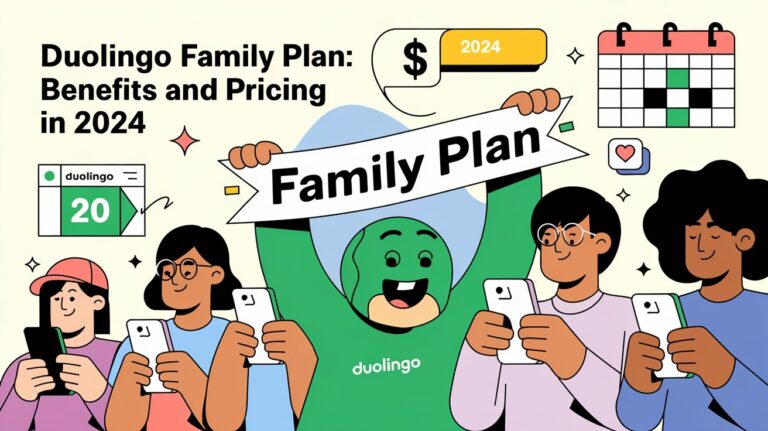When Was Duolingo Created: A Language Learning App’s Origins

Duolingo has changed how people learn languages worldwide. It was started in 2011 by Luis von Ahn and Severin Hacker. Today, it’s the top app for language learning, with over 100 million users every month. They do more than 13 billion exercises each week.
At first, Duolingo was free and fun. Now, it also teaches music and math. It’s based in Pittsburgh, Pennsylvania. Duolingo has made learning new languages easier and more fun.
Key Takeaways
- Duolingo was founded in 2011 by Luis von Ahn and Severin Hacker.
- The company is headquartered in Pittsburgh, Pennsylvania and offers language, music, and mathematics courses through its app.
- Duolingo has become the most popular language learning app globally, with over 100 million monthly active users.
- The platform follows a freemium model, offering both free and premium services.
- Duolingo has attracted significant investment, raising over $100 million in funding since its inception.
When Was Duolingo Created: From Concept to Launch
The story of Duolingo starts in 2009. Luis von Ahn and Severin Hacker came up with the idea at Carnegie Mellon University. They wanted to make learning languages free and easy for everyone worldwide.
The Birth of the Idea in 2009
Von Ahn, a famous computer scientist, and Hacker, his student, started working on Duolingo in 2009. They used von Ahn’s MacArthur fellowship and a grant from the National Science Foundation to fund it. Their goal was to change how people learn new languages.
Private Beta Launch in November 2011
After two years, Duolingo’s private beta launched on November 27, 2011. People were excited, with over 300,000 on a waiting list to try it out.
Public Release in June 2012
On June 19, 2012, Duolingo went public. The waiting list grew to 500,000 users. This was the start of Duolingo’s success, with over 500 million users today.
| Key Milestones | Year |
|---|---|
| Duolingo Concept Formulated | 2009 |
| Private Beta Launch | 2011 |
| Public Release | 2012 |
The Visionaries Behind Duolingo
Duolingo, a top language learning app, was started by Luis von Ahn and Severin Hacker. Von Ahn, a professor at Carnegie Mellon, created CAPTCHA and sold his company to Google. He wanted to make learning English affordable in Guatemala.
Severin Hacker, the CTO, learned to code at 12 in 1996. Together, they made Duolingo a huge success. It now has nearly 50 million users every month and over 300 million worldwide in just nine years.
| Founder | Background | Key Achievements |
|---|---|---|
| Luis von Ahn | German-Guatemalan entrepreneur, Carnegie Mellon University professor | Developed CAPTCHA and reCAPTCHA Sold previous company to Google Awarded the MacArthur Fellowship (Genius Grant) in 2006 Invested millions into his foundation for women’s equality, the environment, and democracy |
| Severin Hacker | Swiss-born post-graduate student | Taught himself computer programming at age 12 Co-founded Duolingo and serves as the CTO Collaborates closely with co-founder Luis von Ahn |
Duolingo aims to make education and language learning available worldwide. This vision has led to its success. With users from all walks of life, including refugees and Bill Gates, Duolingo is set to grow even more.
Early Funding and Development Stages
Duolingo’s journey to becoming a top language-learning platform was fueled by smart funding and steady growth. The company’s funding journey started in October 2011 with a $3.3 million Series A round. This was led by Union Square Ventures, a well-known venture capital firm. This first investment helped Duolingo grow from a promising idea to a real product.
Growth Through Series B to Series F
Duolingo kept attracting investors, getting a $15 million Series B funding in September 2012. Then, it got a $20 million Series C round in February 2014. The company’s success continued with a $45 million Series D in June 2015, a $25 million Series E in July 2017, and a $30 million Series F in December 2019. This duolingo funding helped the platform grow, add more languages, and become a global leader in language education.
Path to Billion-Dollar Valuation
Duolingo’s steady growth and smart duolingo valuation caught the eye of venture capitalists. The company’s value went from $470 million in 2015 to $1.5 billion by 2019. This made Duolingo a “unicorn,” a startup worth $1 billion or more. This valuation showed Duolingo’s success in changing the language-learning world and offering a great, easy, and effective way for users all over the world.
Evolution of the Platform’s Features
Duolingo has changed a lot since it started. It moved from just translating to using games to teach languages. Now, it has points, streaks, and lessons that use spaced repetition. This makes learning fun and effective for users.
Duolingo now offers more than just language. It has Duolingo Math and Duolingo ABC for learning numbers and reading. The app adjusts lessons to fit each user’s level and progress.
Duolingo added video calls and mini-games called Adventures. These features make learning more fun. They also help users practice and improve their language skills.
Duolingo’s growth shows its focus on language learning technology and gamification. It aims to make learning languages engaging and effective. As it keeps improving, Duolingo leads in digital language education, offering a unique learning experience.
| Feature | Description |
|---|---|
| Points and Streaks | Duolingo’s gamification elements, where users earn points for completing lessons and maintain daily learning streaks. |
| Spaced Repetition | An adaptive algorithm that presents vocabulary and grammar concepts at optimal intervals to enhance long-term retention. |
| Duolingo Math and ABC | Expanded educational offerings beyond language learning, covering numeracy and literacy skills. |
| Video Calls and Adventures | Interactive features that blend language practice with engaging, game-like experiences. |
Duolingo’s Business Model Transformation
Duolingo has changed a lot in its business model. It started as a service for translating content. Now, it’s known for its free and paid options, making it a huge success.
From Translation Service to Freemium Model
At first, Duolingo made money by translating content for others. But as it grew, it needed new ways to make money. This led to the freemium model.
This new model offers free and paid versions. The paid options, like Duolingo Plus and Duolingo Max, bring in a lot of money.
Revenue Streams and Monetization Strategy
Today, Duolingo makes money from ads, subscriptions, and the Duolingo English Test. The Duolingo Plus subscription is a big part of its income, making up 72% in 2021.
The Duolingo English Test is also a big money-maker. It’s cheaper than other tests and is recognized by over 3,000 schools worldwide. This helps Duolingo make more money from language tests.
Duolingo’s move to the freemium model has helped it grow. It keeps its service free while making money from subscriptions and tests. This way, Duolingo can keep improving and growing.
Language Course Expansion and Growth
Duolingo has become a top name in language learning, offering courses in 43 languages. You can learn popular languages like English, Spanish, and French. Or try something unique like Hawaiian, Navajo, or High Valyrian from Game of Thrones.
This wide range of languages meets the varied interests and needs of learners around the world.
Duolingo’s approach to creating courses has changed over time. At first, it relied on volunteers to add new languages. But as it grew, it started using professional linguists. This ensures courses meet CEFR standards, offering a better learning experience.
But Duolingo doesn’t stop at languages. It also offers courses in math and music. This shows Duolingo’s aim to be a full educational platform. It wants to meet the learning needs of its over 500 million users worldwide.
Frequently Asked Questions
When was Duolingo created?
Duolingo was founded in 2011 by Luis von Ahn and Severin Hacker.
Where is Duolingo headquartered?
Duolingo is headquartered in Pittsburgh, Pennsylvania.
What does Duolingo offer beside language courses?
Duolingo offers language, music, and mathematics courses through its app.
How popular is Duolingo?
Duolingo is the most popular language learning app globally. It has over 100 million monthly active users. They complete more than 13 billion exercises per week.
What is Duolingo’s business model?
Duolingo follows a freemium model. It offers both free and premium services.
How was the concept for Duolingo formulated?
The concept for Duolingo was formulated in 2009. Luis von Ahn and Severin Hacker worked on it at Carnegie Mellon University.
When did Duolingo launch its private and public beta?
Duolingo launched a private beta on November 27, 2011. It had a waiting list of over 300,000 people. The public release was on June 19, 2012. The waiting list then grew to around 500,000 users.
Who founded Duolingo?
Duolingo was founded by Luis von Ahn and Severin Hacker. Luis is a German-Guatemalan entrepreneur and professor at Carnegie Mellon University. Severin is his Swiss-born post-graduate student.
How has Duolingo’s funding journey progressed?
Duolingo’s funding journey started with a $3.3 million Series A round in October 2011. Union Square Ventures led it. Later, it received $15 million Series B in September 2012, $20 million Series C in February 2014, $45 million Series D in June 2015, $25 million Series E in July 2017, and $30 million Series F in December 2019. Its valuation grew from $470 million in 2015 to $1.5 billion by 2019, making it a unicorn.
How has Duolingo’s platform evolved over time?
Duolingo’s platform has grown a lot since it started. It began with crowdsourced translation but now focuses on gamified language learning. The app uses points, streaks, and interactive lessons.
It has also added Duolingo Math and Duolingo ABC for literacy. The platform uses adaptive algorithms to personalize lessons. It has introduced video calls and mini-games called Adventures.
How has Duolingo’s business model changed?
Duolingo’s business model changed from crowdsourced translation to a freemium model. It introduced advertising and premium subscriptions like Super Duolingo and Duolingo Max. It makes money from ad revenue, subscription fees, and the Duolingo English Test certification program.
How many languages does Duolingo offer?
Duolingo now offers courses for 43 languages. It includes popular languages like English, Spanish, and French. It also offers less common languages like Hawaiian, Navajo, and High Valyrian.






